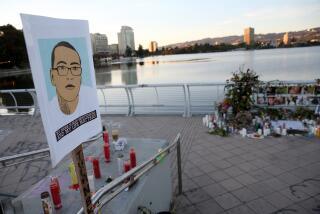Documents shed more light on Trayvon Martin shooting
ATLANTA — On the night George Zimmerman fatally shot unarmed black teenager Trayvon Martin in Florida, a witness said he saw some of the scuffle — and described a black man in a dark hoodie on top of a white or Latino man, punching him repeatedly, “mixed martial arts style.”
Then there was a pop, the witness told police, according to documents made public Thursday in Zimmerman’s second-degree murder case. Soon, he said, the man in the hoodie was “laid out in the grass.”
The detail, one of many in a trove of discovery records released by prosecutors, could bolster Zimmerman’s contention that he acted in self-defense on the night of Feb. 26, after he called police and reported Martin as a suspicious character in his neighborhood.
But the documents also show that Sanford, Fla., police investigators believed that Zimmerman had erred in the way he dealt with the young man. That led to their recommendation in March that Zimmerman be charged with negligent manslaughter — which the state attorney’s office initially did not act on, setting off a wave of national protest and concern that racial issues had tainted the handling of the case.
Zimmerman not only reported Martin to police, he also followed him. A police dispatcher told him it wasn’t a good idea. Investigators subsequently agreed.
“The encounter between George Zimmerman and Trayvon Martin was ultimately avoidable by Zimmerman, if Zimmerman had remained in his vehicle and awaited the arrival of law enforcement,” they wrote in a March 13 capias document, which authorizes an arrest. “Or conversely if he had identified himself to Martin as a concerned citizen and initiated dialog in an effort to dispel each party’s concern.”
Zimmerman, 28, was arrested on April 11 and charged with second-degree murder after the case was turned over to a special prosecutor appointed by Florida’s Republican governor, Rick Scott.
Zimmerman pleaded not guilty and is out on bond awaiting trial. He claims he shot Martin in self-defense after Martin confronted him. But prosecutors, in a probable-cause affidavit, have stated that Zimmerman confronted Martin.
The documents include audio recordings of investigators’ interviews with witnesses, and 183 pages of police reports and other records, some of them partially redacted.
They include numerous detailed witness accounts of the altercation. In a March 13 police report, however, Sanford investigator Christopher Serino wrote that “the initial harmful event” had “no known eyewitnesses.”
Much of the information will likely feature prominently at Zimmerman’s trial. Some of the details have been previously leaked to news outlets. Others are new, including:
• A finding by the medical examiners that Martin had THC, the psychoactive ingredient in marijuana, in his blood. At the time of the shooting, Martin was serving a suspension from his high school for possessing a bag containing marijuana residue.
• The revelation that a Sanford police investigator, Trekell Perkins, received a phone call two days after the shooting from an anonymous woman who said Zimmerman had “racist ideologies,” and was “fully capable” of instigating a deadly confrontation. Police noted that no other information was obtained to corroborate the claim, and friends and family of the suspect, who is half Latino, say he is not prejudiced.
• A Florida Department of Law Enforcement lab report, based on a study of the bullet hole in Martin’s clothing, that determined he was shot at extremely close range.
• An FBI analysis of a 911 call made by a witness during the confrontation. The call included the sound of someone in the background yelling repeatedly for help. The analysts could not identify the person. When police played the recording for Tracy Martin, Trayvon Martin’s father, he said the voice was not his son’s.
A number of residents of Zimmerman’s gated town house community heard a ruckus when the confrontation began and called 911. When police arrived, they found Martin lying still in the grass. Eventually they found a wound, where one bullet had entered his chest and hit his heart.
They also found Zimmerman, who had a bloody nose that appeared to be broken and blood on the back of his head.
The documents include a recording of a police interview with Martin’s girlfriend, who says she was on the phone with Martin when he told her a white man in a car was watching him and then following him. From the breathing, it sounded like he was running.
“I know he was scared,” she said.
Martin went to the back of the building where he’d been staying and told her that he thought he had lost the man. But the man reappeared, he told her.
“What are you following me for?” she quotes Martin as saying.
Then she said she heard another voice. “What are you doing around here?” it said.
From interviews, investigators appear to have picked up bits and pieces of witness accounts of the altercation — some of which are contradictory or not totally clear.
One woman said she saw a chase, with one man about 10 or 12 feet behind the other, but she couldn’t tell who was chasing whom.
Another woman said she heard no fighting at all — no hitting, no shouting — before she heard the gunshot through her open kitchen window. All she heard, she said, was a whining, crying sound.
She and a neighbor went outside and saw a man standing over a teenager, who was lying facedown. The man was pressing on the teenager’s back, they said.
One woman said she asked the man three times what was going on.
“Just call the police,” he said.
molly.hennessy-fiske@latimes.com
Fausset reported from Atlanta, Muskal from Los Angeles and Hennessy-Fiske from Houston.
More to Read
Start your day right
Sign up for Essential California for news, features and recommendations from the L.A. Times and beyond in your inbox six days a week.
You may occasionally receive promotional content from the Los Angeles Times.








